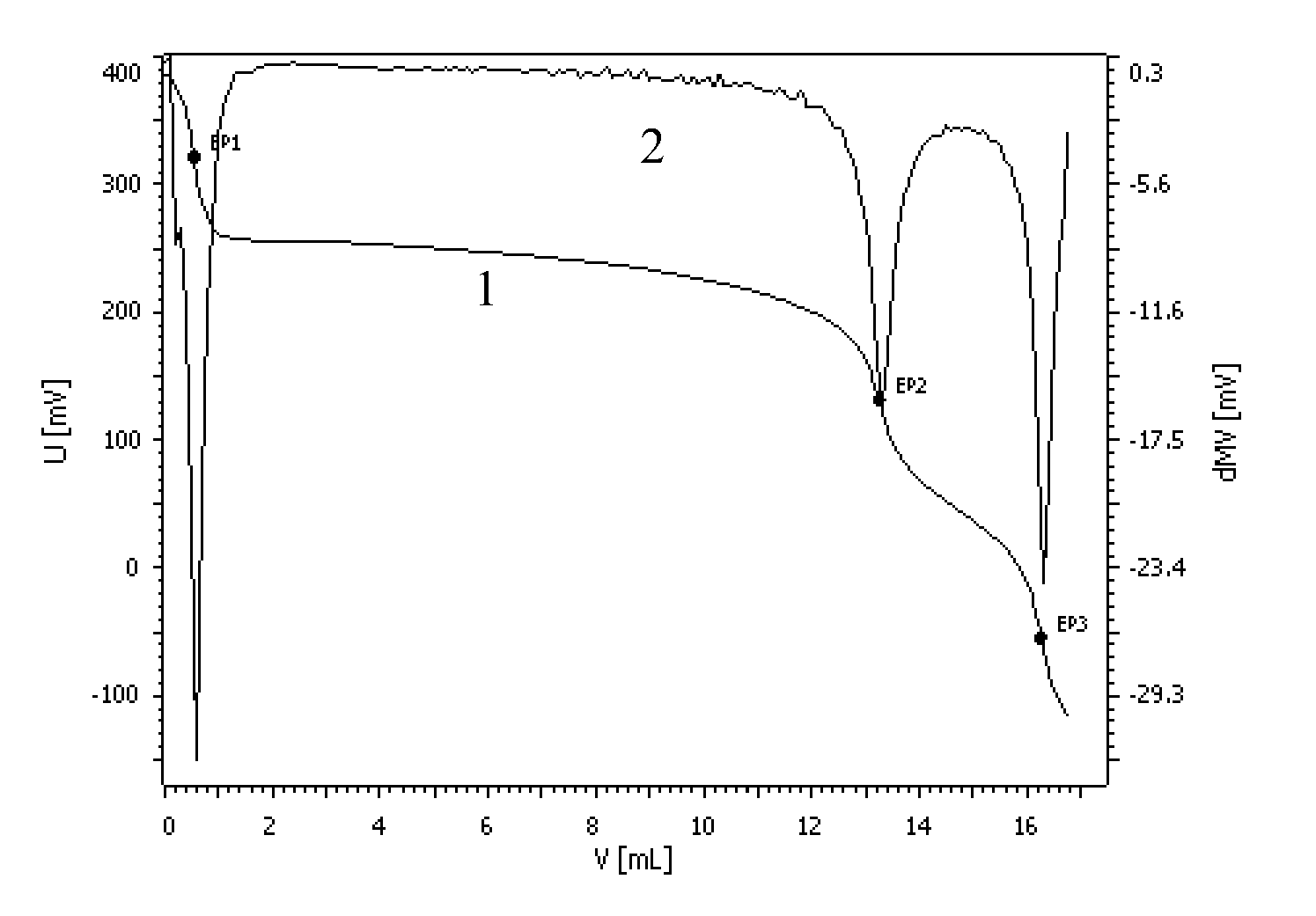Potentiometric titration method of a mixed acid solution
a technology of potentiometric titration and acid solution, which is applied in chemical methods analysis, instruments, chemistry apparatus and processes, etc., can solve the problems of increased uncertainty, reduced accuracy and worse reproducibility of titration results, and achieves enhanced titration test efficiency, reduce the viscosity coefficient of the titration environment, and reduce the recognition time of the electrode end point
- Summary
- Abstract
- Description
- Claims
- Application Information
AI Technical Summary
Benefits of technology
Problems solved by technology
Method used
Image
Examples
embodiment 1
Embodiment 1 according to the present invention includes steps as follows.
[0023]Step 1, an alkali-ethylene glycol solution of a concentration in 0.1˜0.2 mol / L is prepared, and the concentration of the alkali-ethylene glycol solution is titrated with a basis reagent by using an automatic titrator. In this embodiment, the alkali-ethylene glycol solution is a potassium hydroxide (KOH)-ethylene glycol solution prepared with analytical pure KOH.
[0024]In step 1, 65.9 g of KOH (analytical pure concentration greater than 85%) is accurately weighed by using an electronic balance, the KOH is dissolved with an appropriate amount of ethylene glycol to form the KOH-ethylene glycol solution of a concentration about 1 mol / L, the KOH-ethylene glycol solution is kept still and precipitated for 15 days, an appropriate amount of an upper clear liquid in the alkali-ethanol solution is extracted, the upper clear liquid is diluted with an appropriate amount of ethylene glycol to a preferred concentration...
embodiment 2
[0050]In this embodiment, a KOH-ethylene glycol solution is prepared as the description of Step 1 in Embodiment 1. Then, 75.3 mL (V1) of a first solvent (ethanol) and 4.7 mL (V2) of a second solvent (ethylene diamine) are added into and stirred with 0.2 g of the mixed acid solution prepared as Step 2 in Embodiment 1 to form a mixed system, wherein a mass of the mixed acid in a ratio of a total volume of the first solvent and the second solvent is 1 g:400 mL. Then, the mixed system is titrated with the KOH-ethylene glycol solution to obtain three equivalence points (EP1, EP2 and EP3) of the nitric acid, phosphoric acid and acetic acid in the mixed system by using the automatic titrator, and concentrations of the nitric acid, phosphoric acid and acetic acid are respectively measured. The above titration is parallel performed by three times, and averaged concentrations of the nitric acid, phosphoric acid and acetic acid are respectively obtained.
[0051]The specific titration results and...
embodiment 3
[0054]In this embodiment, butylamine is selected as a second solvent, 75.3 mL (V1) of a first solvent (ethanol) and 4.7 mL (V2) of a second solvent (butylamine) are added into and stirred with 0.2 g of the mixed acid solution prepared as Step 2 in Embodiment 1 to form a mixed system, wherein a volume ratio of the first solvent (ethanol) to the second solvent (butylamine) is 16:1, and a mass of the mixed acid in a ratio of a total volume of the first solvent and the second solvent is 1 g:400 mL. Then, the mixed system is titrated with the KOH-ethylene glycol solution to obtain three equivalence points (EP1, EP2 and EP3) of the nitric acid, phosphoric acid and acetic acid in the mixed system by using the automatic titrator, and concentrations of the nitric acid, phosphoric acid and acetic acid are respectively measured. The above titration is parallel performed by three times, and averaged concentrations of the nitric acid, phosphoric acid and acetic acid are respectively obtained.
[00...
PUM
| Property | Measurement | Unit |
|---|---|---|
| total volume | aaaaa | aaaaa |
| pKa | aaaaa | aaaaa |
| pKa | aaaaa | aaaaa |
Abstract
Description
Claims
Application Information
 Login to View More
Login to View More - R&D
- Intellectual Property
- Life Sciences
- Materials
- Tech Scout
- Unparalleled Data Quality
- Higher Quality Content
- 60% Fewer Hallucinations
Browse by: Latest US Patents, China's latest patents, Technical Efficacy Thesaurus, Application Domain, Technology Topic, Popular Technical Reports.
© 2025 PatSnap. All rights reserved.Legal|Privacy policy|Modern Slavery Act Transparency Statement|Sitemap|About US| Contact US: help@patsnap.com



